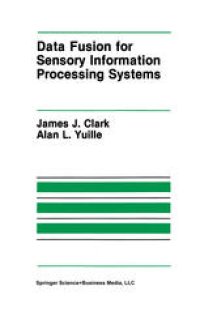
Ebook: Data Fusion for Sensory Information Processing Systems
- Tags: Control Robotics Mechatronics, Computer Imaging Vision Pattern Recognition and Graphics, Artificial Intelligence (incl. Robotics)
- Series: The Springer International Series in Engineering and Computer Science 105
- Year: 1990
- Publisher: Springer US
- Edition: 1
- Language: English
- pdf
The science associated with the development of artificial sen sory systems is occupied primarily with determining how information about the world can be extracted from sensory data. For example, computational vision is, for the most part, concerned with the de velopment of algorithms for distilling information about the world and recognition of various objects in the environ (e. g. localization ment) from visual images (e. g. photographs or video frames). There are often a multitude of ways in which a specific piece of informa tion about the world can be obtained from sensory data. A subarea of research into sensory systems has arisen which is concerned with methods for combining these various information sources. This field is known as data fusion, or sensor fusion. The literature on data fusion is extensive, indicating the intense interest in this topic, but is quite chaotic. There are no accepted approaches, save for a few special cases, and many of the best methods are ad hoc. This book represents our attempt at providing a mathematical foundation upon which data fusion algorithms can be constructed and analyzed. The methodology that we present in this text is mo tivated by a strong belief in the importance of constraints in sensory information processing systems. In our view, data fusion is best un derstood as the embedding of multiple constraints on the solution to a sensory information processing problem into the solution pro cess.
Content:
Front Matter....Pages i-xix
Introduction: The Role of Data Fusion in Sensory Systems....Pages 1-16
Bayesian Sensory Information Processing....Pages 17-38
Information Processing Using Energy Function Minimization....Pages 39-69
Weakly vs. Strongly Coupled Data Fusion: A Classification of Fusional Methods....Pages 71-104
Data Fusion Applied to Feature Based Stereo Algorithms....Pages 105-135
Fusing Binocular and Monocular Depth Cues....Pages 137-146
Data Fusion in Shape From Shading Algorithms....Pages 147-180
Temporal Aspects of Data Fusion....Pages 181-215
Towards a Constraint Based Theory of Sensory Data Fusion....Pages 217-222
Back Matter....Pages 223-242
Content:
Front Matter....Pages i-xix
Introduction: The Role of Data Fusion in Sensory Systems....Pages 1-16
Bayesian Sensory Information Processing....Pages 17-38
Information Processing Using Energy Function Minimization....Pages 39-69
Weakly vs. Strongly Coupled Data Fusion: A Classification of Fusional Methods....Pages 71-104
Data Fusion Applied to Feature Based Stereo Algorithms....Pages 105-135
Fusing Binocular and Monocular Depth Cues....Pages 137-146
Data Fusion in Shape From Shading Algorithms....Pages 147-180
Temporal Aspects of Data Fusion....Pages 181-215
Towards a Constraint Based Theory of Sensory Data Fusion....Pages 217-222
Back Matter....Pages 223-242
....